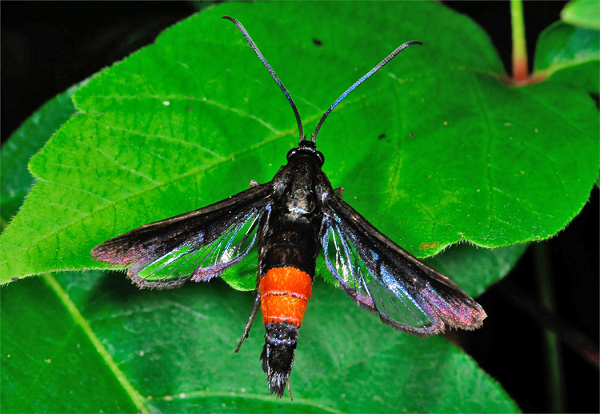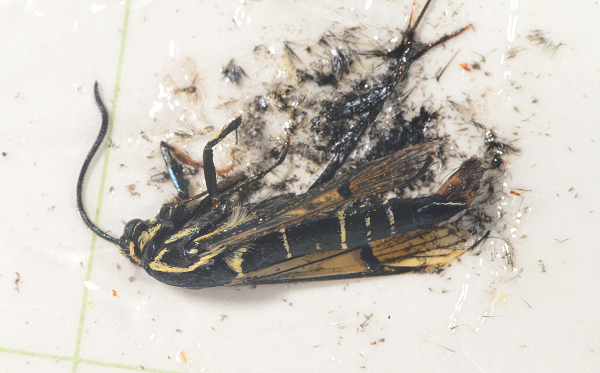Peachtree Borer
ENTFACT-200: Peachtree Borer | Download PDF
by Ric Bessin, Extension Specialist
University of Kentucky College of Agriculture
The peachtree borer is a native North American pest that causes serious damage to peach, cherry, plum, nectarine, and apricot. Damage is caused by the larval stage, primarily to younger trees. Larvae tunnel into the roots and lower trunks of the hosts feeding on the growing tissue and inner bark. Young trees may be completely girdled and older trees may have their crop bearing capacity greatly reduced. Infested trees may yellow and eventually die as the larvae girdle the tree at the crown.
The adult peachtree borer is a clear wing moth with a 1-1/4 wing span. Unlike the majority of moths, these fly during the day and are most active from 10 a.m. to 2 p.m. The female and male moths differ in appearance. The female is dark, steel blue with one or two wide orange bands around her abdomen. Her front wings are opaque while the hind ones are clear. The male moth is smaller and more slender. It is also steel blue, but has several narrow-yellow bands around the abdomen. Both pairs of wings are clear.

Figure 1. Female peachtree borer with the characteristic dark wings and banded abdomen.
Egg laying begins shortly after the moths emerge and lasts only a few days. The eggs are deposited on the trunk at or near the base. Females lay 500-600 eggs on average. The larvae will begin to hatch in 9 to 10 days. Upon hatching, the larvae wander down the trunk to the soil line and burrow into the bark, often entering through a crack or wound. When full grown, the larva is 1-1/4 in long, cream colored with a dark brown head. The winter is spent as a larva under the bark. In the spring the larva will construct a silken cocoon and cover it with tiny bits of chewed wood. The borer will remain in the pupal stage from 18 to 30 days before emerging as an adult. There is a single generation per year. Infestation by the peachtree borer is often identified by oozing of gum around the base of the tree. The gum is usually mixed with dirt and reddish-brown frass. Frequently empty brown pupal cases can be found around the base of damaged trees, either at the head of the larval gallery or in the soil close to the tree trunk.

Figure 2. Male peachtree borer caught in pheromone trap. Note the clear wings and narrow bands on the abdomen.
Prevention Key to Control
Control of peach tree borers in commercial orchards relies on preventing the larval establishment underneath the bark. Once under the bark, chemical control is ineffective. Insecticides should be timed to coincide with initial egg hatch in order to be effective. To aid in the timing of sprays, pheromone traps are used to alert producers to the presence and activity of peachtree borer moths. Because egg hatch begins about 9 to 10 days after the moths emerge, insecticidal sprays should be applied 7 to 14 days after the first male peachtree borer moths are captured in the traps.
Sprays containing Asana XL, Lorsban, and Warrior are labeled for control of peachtree borer on peaches. Directed sprays should be applied uniformly to the trunk from the base to the lower limbs. Thoroughly wet the bark. Do not allow Lorsban sprays to contact fruit foliage. Asana XL, while Warrior and Lorsban have 14 day preharvest intervals Asana XL, Warrior, and Lorsban are RESTRICTED USE insecticides.
Pheromone Trapping
Pheromone trapping uses chemical lures to attract male moths. These lures are synthetic copies of the chemicals female moths use to attract the mates. Moth captures in pheromone traps alert growers to pest activity and aid timing of insecticide sprays. A trap consists of plastic top and bottom held together by a wire hanger with the lure placed inside. The inner surface of the bottom is coated with a sticky material to hold the insects once they land in the trap. Traps are hung in the tree at eye level, usually one for each ten acres of trees (minimum of two traps per orchard) in commercial orchards. For a list of source of the various types of pheromone traps, see ENT-54, Vendors of Microbial and Botanical Insecticides and Insect Monitoring Devices.
Moth activity can occur anytime between mid-June and early August. In order to detect the first activity, traps should be hung in tree well in advance of the anticipated flight. Usually this means hanging traps shortly after petal-fall. Trap lures need to be replaced once a month. Traps bottoms should be replaced when the stick surface becomes clogged with other debris.
Proper identification of the moths captured in the trap is essential. There are many other moths which may wander into the trap, even other clear wing moths, such as the lilac borer or dogwood borer. Check the description of the male peachtree borers above. The lilac borer has red and black antennae, yellow and red legs, and the front wings are opaque black. The dogwood borer has thin yellow abdominal bars on the abdomen similar to the male peachtree borer, but the tips of the front wings have a broad black tips.
Mating Disruption
Mating disruption relies on confusion to prevent peachtree borers from mating. Male peachtree borer moths normally locate female moths at night by following the sex attractant released into the air by the females. Mating disruption uses commercial dispensers of synthetic sex attractant to prevent male moths from locating females. Males are overwhelmed by the amount of pheromone and become desensitized to it. The result is that unfertilized moths are not able to lay viable eggs. Unlike other methods, peachtree borer moths are not killed with this technique. This technique is most successful in blocks of at least 5 acres and where initial populations of peachtree borer moth are low. There may be some damage along rows boarder woods or other areas that may be sources of already mated females. Keep in mind that mating disruption for peachtree borer will not control other insects that are normally controlled with cover sprays (plum curculio for example). Pheromone traps are used to ensure that the technique is working properly, as the male moths should not be able to locate the traps.
Worming Trees May be an Alternative
Before the development of chemicals for controlling peachtree borers, producers relied on digging the borers out of the bark by hand. This is still an alternative for backyard gardeners in the fall. Dirt should be removed from around the base of the tree to a depth of 4 to 5 inches. Care should be taken not to cut the sound bark more than necessary, and cutting should be done vertically. Carelessness may result in more damage to the tree than the damage that would have been caused by the borers! After the larvae have been located and removed, the dirt should be replaced around the base of the tree to the original level.
Revised: 11/19
CAUTION! Pesticide recommendations in this publication are registered for use in Kentucky, USA ONLY! The use of some products may not be legal in your state or country. Please check with your local county agent or regulatory official before using any pesticide mentioned in this publication.
Of course, ALWAYS READ AND FOLLOW LABEL DIRECTIONS FOR SAFE USE OF ANY PESTICIDE!
Photos: R. Bessin, University of Kentucky Entomology
